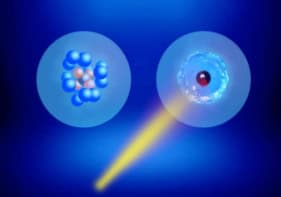Scientists have long expected solid hydrogen to become a metal when it is compressed, but so far electrical conductivity has only been detected in liquid hydrogen. Now an experimental study of solid hydrogen at pressures up to 320 GPa predicts that it will become metallic at a pressure of 450 GPa – over four million times atmospheric pressure. René LeToullec and co-workers at the CEA in France also found that solid hydrogen becomes opaque – or ‘black’ – under compression (P Loubeyre et al 2002 Nature 416 613).
Both the structure and electrical conduction of solid hydrogen have been intensively studied since the 1930s, when the existence of its metallic state was first proposed. Experiments conducted in the early 1990s squeezed the element to pressures of 250 GPa but failed to detect this state. More recent investigations at higher pressures have proved inconclusive, partly because the pressure cell starts to interfere with the measurements.
Now the French team has succeeded in compressing hydrogen to 320 GPa, at a temperature of 100 kelvin. They filled a specially designed diamond pressure cell with hydrogen, and measured its absorption of light across the spectrum as they increased the pressure. This technique – based on Raman spectroscopy – produced an absorption pattern that revealed the vibrational and rotational energy levels of the hydrogen molecules, providing information about the structure of the solid element.
At 290 GPa, LeToullec and colleagues discovered that the hydrogen sample turned white, then yellow, orange and red, before becoming opaque at 320 GPa. They also established that its structure remains stable above a pressure of 160 GPa.
Above 300 GPa, they found evidence for an energy bandgap – a well-known feature of semiconductors. This bandgap narrowed as the pressure rose to 320 GPa, the highest value reached in the experiment. By extrapolation, the team calculated that the bandgap would disappear at 450 GPa to become an atomic metal.
The team believes that this estimate is more reliable than earlier predictions of around 620 GPa, which were based on larger extrapolations. LeToullec and colleagues now hope that their technique could be extended to study pressures in the 400 GPa range, where it could detect solid hydrogen metal for the first time.



